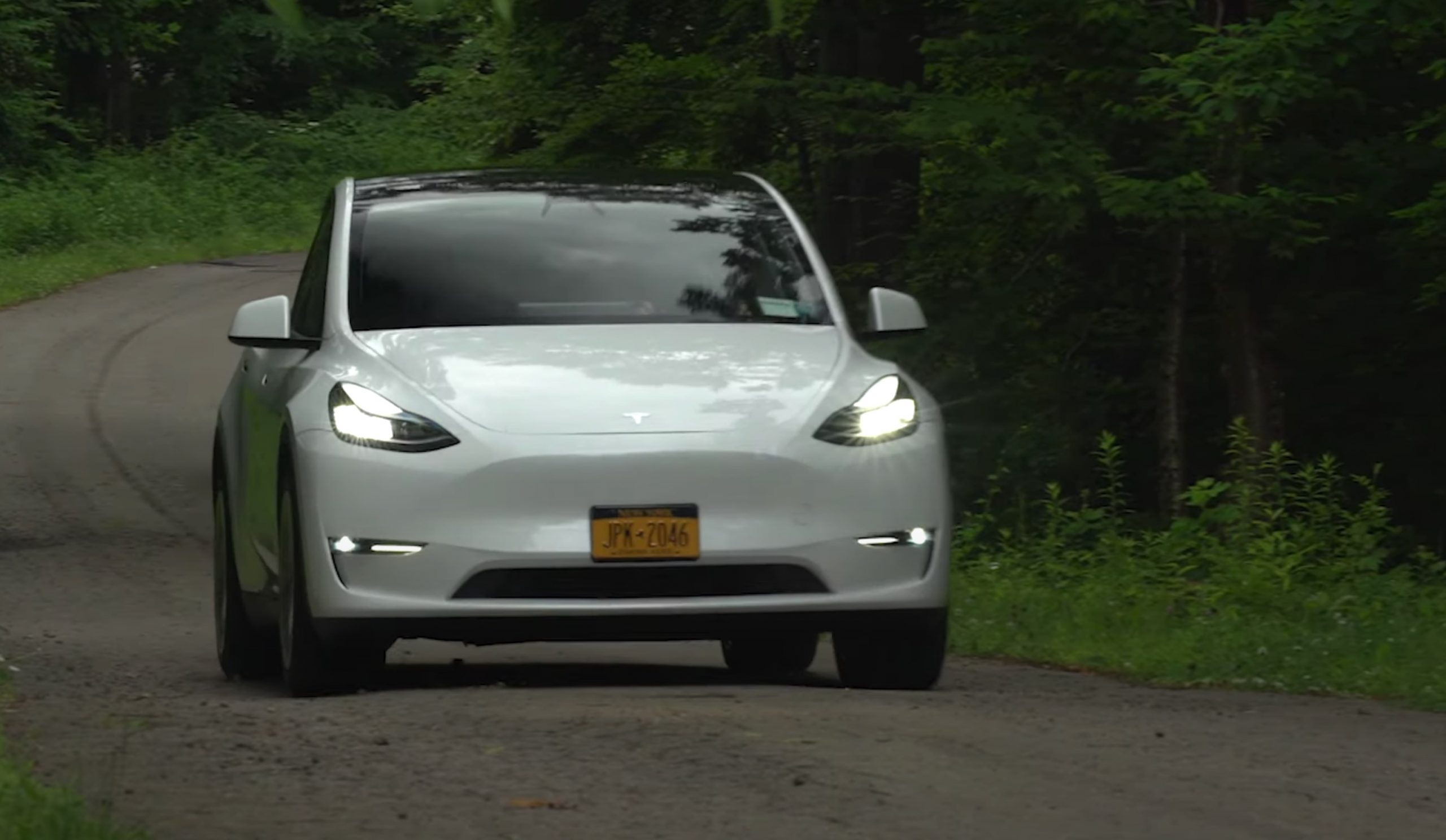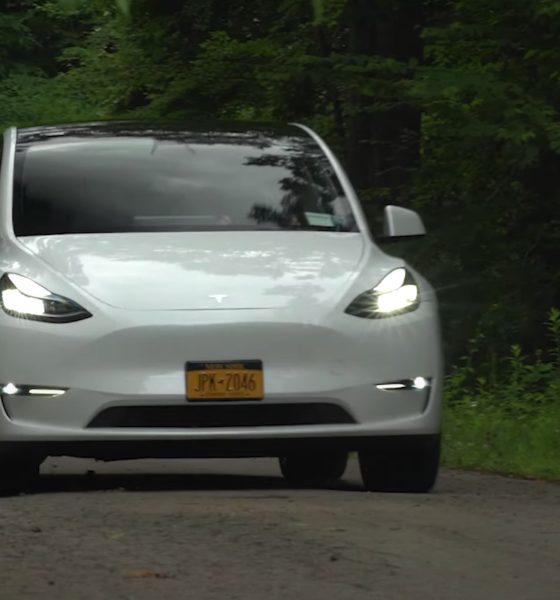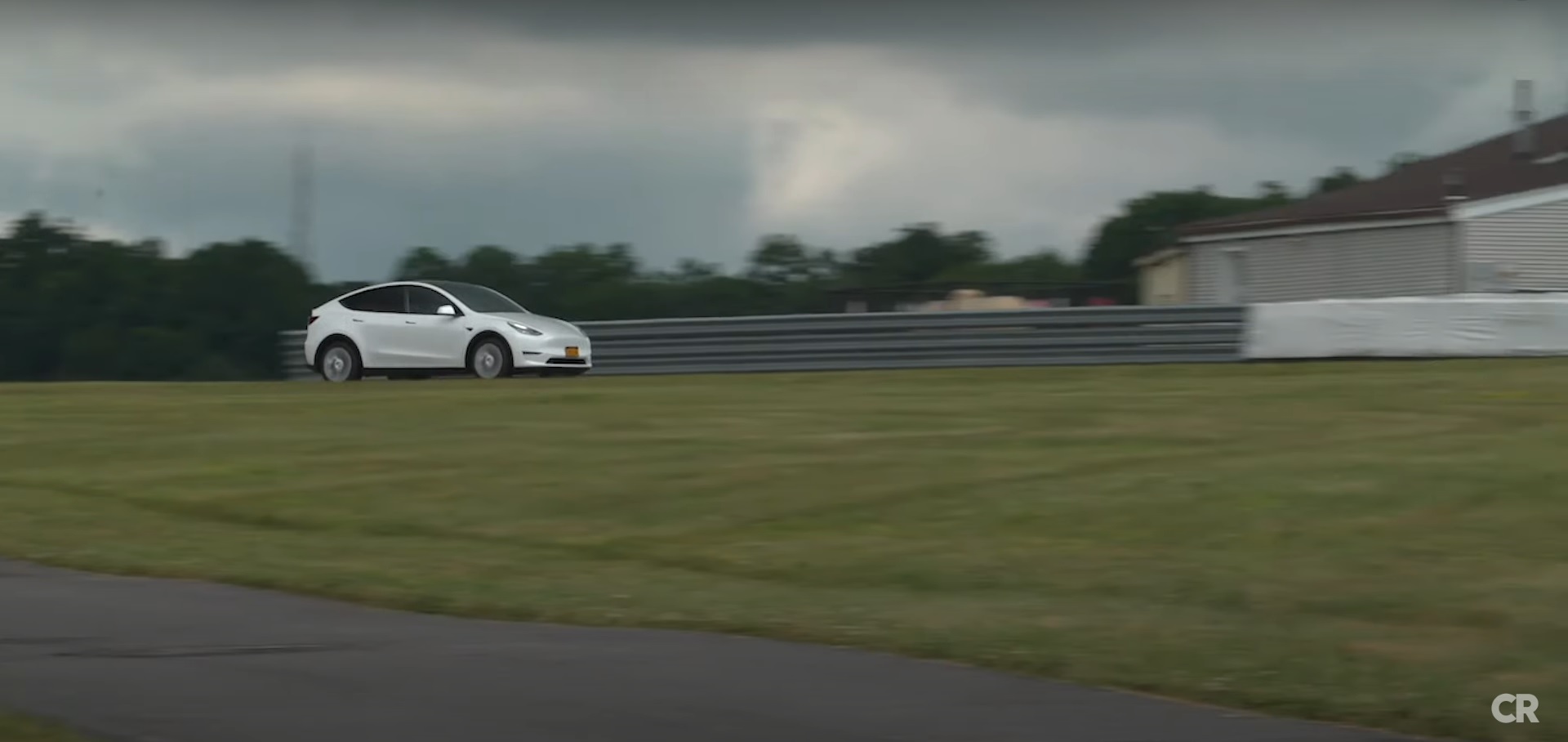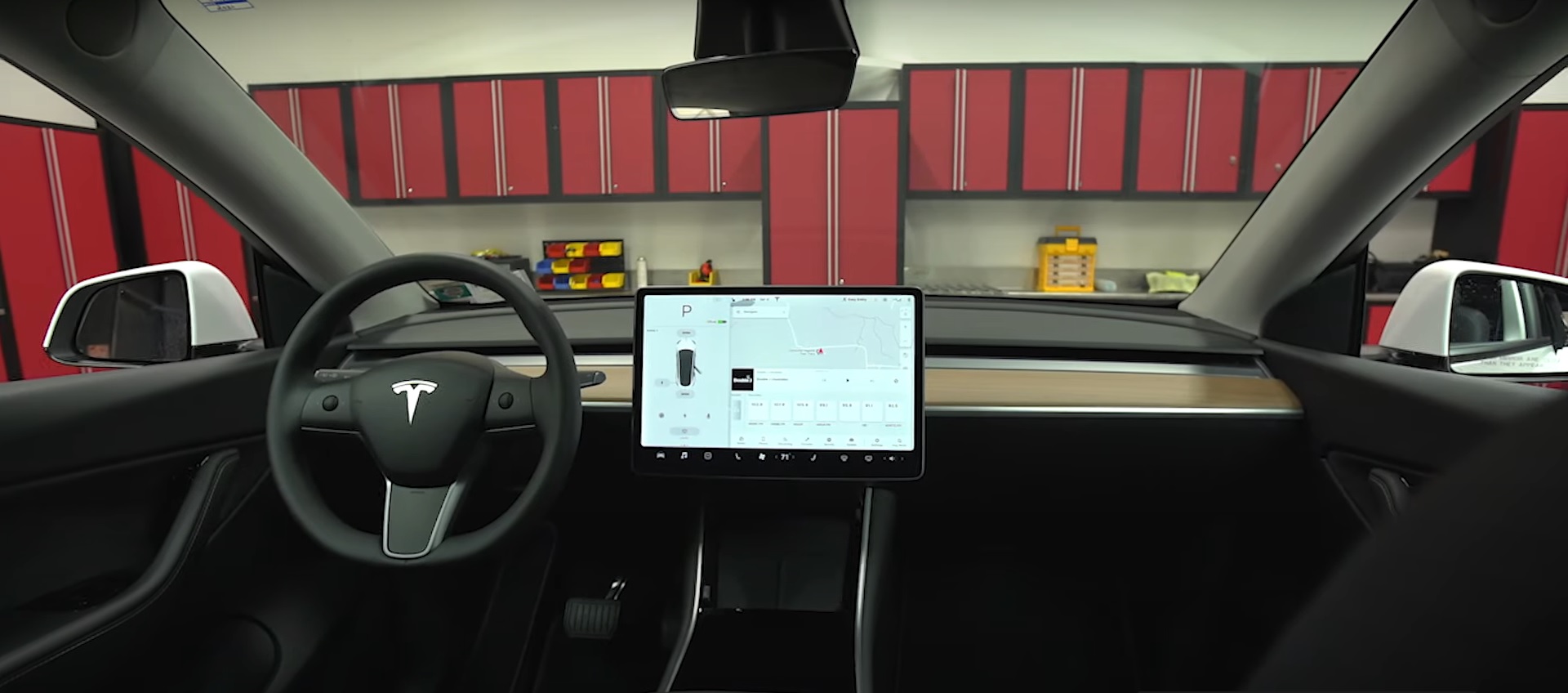

Lifestyle
Tesla Model Y hits a high note with Consumer Reports but with some criticism
The crew at Consumer Reports has been testing out Tesla’s Model Y, and while the all-electric crossover was pleasantly received, some mild criticisms were discussed in a recent Talking Cars podcast focused on their first impressions.
The Model Y being reviewed was a white, Dual Motor Long Range version of the vehicle with All-Wheel Drive and Full Self Driving option package, enabling a review of both the car’s driveability and currently available Autopilot features. Jake Fisher, Consumer Reports’ (CR) Auto Test Director, first noted the fun, sporty nature of the Model Y’s driving style, but all participants agreed that labeling the vehicle as an SUV was a misnomer.
“Big picture what you see is basically a Model 3 hatchback,” Fisher commented. The dispute over style classification, however, was put into a positive light. Specifically, adding the hatchback-type design features solved what the group characterized as “deficiencies” in Model 3. “The benefit is you get extra headroom and especially the rear seat room,” noted Mike Monticello, Autos Editor for CR. “It’s like it took all the good things about the Model 3, it kept them…but it took some of the bad things…and made them better… It’s an improved Model 3, if you think about it that way.”

Some deficiencies still carried over to the Model Y, though, according to the review. Fisher took issue with the center console screen carryover in particular. “They crammed everything into this one screen that is off-center,” he said, also noting that Tesla had “an opportunity” to improve the usability of the Model 3 features which were missed in the Model Y. In particular, the group wanted the ability to adjust the steering wheel, change the air vents without going through a screen menu, and add automatic rearview mirror adjustment a part of the driver profile functionality.
The actual road-handling and driving experience of the Model Y was also critiqued as failing to be improved from the Model 3 experience. Mike Monticello, also an Autos Editor with CR, noted the car’s stiff ride and wind noise in the cabin, both of which are not issues in the Model S or Model X. Monticello also noted the tire noise while traveling and encountering road bumps.

Tesla’s latest beta Autopilot feature made its way into the crosshairs during the talk as well, specifically the Traffic Light and Stop Sign Control function which can be toggled on and off. The feature previously caused the Model Y to stop at every red, yellow, and green light, but now only stops at a green light if there isn’t a car in front of the vehicle. “They keep on changing the behavior of how this car drives,” Fisher noted, also mentioning that the constant updates don’t add to the relaxation or sense of safety that Autopilot is supposed to provide.
Despite the noted criticisms from the Consumer Reports group, the review session still ended on a positive note for Tesla and the Model Y. They offered caution to consumers until the new crossover had been out on the market for about a year to judge first-run reliability issues, but they acknowledged that alternative electric vehicles were likely not up to par for those interested in Tesla specifically.
Although there are options when looking for a vehicle that supports environmental concerns, the mindset of a current Tesla owner likely won’t match the features offered by other automakers with electric vehicles such as the Hyundai Kona, Fisher summarized. “Other electric cars don’t have that ‘Tesla Mystique’ … [they don’t drive like] … a performance car.”
You can watch the Consumer Reports full Model Y podcast below:

Lifestyle
Tesla Model S Plaid battles China’s 1500 hp monster Nurburgring monster, with surprising results
There is just something about Tesla’s tuning and refinement that makes raw specs seem not as game-changing.

The Tesla Model S Plaid has been around for some time. Today, it is no longer the world’s quickest four-door electric sedan, nor is it the most powerful. As per a recent video from motoring YouTube channel Carwow, however, it seems like the Model S Plaid is still more than a match for some of its newer and more powerful rivals.
The monster from China
The Xiaomi SU7 Ultra is nothing short of a monster. Just like the Model S Plaid, it features three motors. It also has 1,548 hp and 1,770 Nm of torque. It’s All Wheel Drive and weighs a hefty 2,360 kg. The vehicle, which costs just about the equivalent of £55,000, has been recorded setting an insane 7:04.957 at the Nurburgring, surpassing the previous record held by the Porsche Taycan Turbo GT.
For all intents and purposes, the Model S Plaid looked outgunned in Carwow’s test. The Model S Plaid is no slouch with its three motors that produce 1,020 hp and 1,420 Nm of torque. It’s also a bit lighter at 2,190 kg despite its larger size. However, as the Carwow host pointed out, the Model S Plaid holds a 7:25.231 record in the Nurburgring. Compared to the Xiaomi SU7 Ultra’s record, the Model S Plaid’s lap time is notably slower.
Real-world tests
As could be seen in Carwow’s drag races, however, Tesla’s tech wizardry with the Model S Plaid is still hard to beat. The two vehicles competed in nine races, and the older Model S Plaid actually beat its newer, more powerful counterpart from China several times. At one point in the race, the Xiaomi SU7 Ultra hit its power limit due to its battery’s temperature, but the Model S Plaid was still going strong.
The Model S Plaid was first teased five years ago, in September 2020 during Tesla’s Battery Day. Since then, cars like the Lucid Air Sapphire and the Xiaomi SU7 Ultra have been released, surpassing its specs. But just like the Model Y ended up being the better all-rounder compared to the BYD Sealion 7 and the MG IM6, there is just something about Tesla’s tuning and refinement that makes raw specs seem not as game-changing.
Check out Carwow’s Model S Plaid vs Xiaomi SU7 drag race video below.
Lifestyle
500-mile test proves why Tesla Model Y still humiliates rivals in Europe
On paper, the BYD Sealion 7 and MG IM6 promised standout capabilities against the Model Y.

BYD is seeing a lot of momentum in Europe, so much so that mainstream media has taken every opportunity to argue that the Chinese automaker has beaten Tesla in the region. But while BYD sales this year in Europe are rising and Tesla’s registrations remain challenged, the raw capabilities of vehicles like the Model Y are difficult to deny.
This was highlighted in a 500-mile challenge by What Car? magazine, which showed that the new Tesla Model Y is more efficient, cheaper to run, and more reliable than rivals like the BYD Sealion 7, and even the nearly 400 KW-charging MG IM6.
Range and charging promises
On paper, the BYD Sealion 7 and MG IM6 promised standout capabilities against the Model Y. The Sealion 7 had more estimated range and the IM6 promised significantly faster charging. When faced with real-world conditions, however, it was still the Model Y that proved superior.
During the 500-mile test, the BYD nearly failed to reach a charging stop, arriving with less range than its display projected, as noted in a CarUp report. MG fared better, but its charging speeds never reached its promised nearly-400 kW charging speed. Tesla’s Model Y, by comparison, managed energy calculations precisely and arrived at each stop without issue.
Tesla leads in areas that matter
Charging times from 25% to 80% showed that the MG was the fastest at 17 minutes, while Tesla and BYD were close at 28 and 29 minutes, respectively. Overall efficiency and cost told a different story, however. The Model Y consumed 19.4 kWh per 100 km, compared to 22.2 for MG and 23.9 for BYD. Over the full trip, Tesla’s charging costs totaled just £82 thanks to its supercharger network, far below BYD’s £130 and MG’s £119.
What Car? Magazine’s testers concluded that despite BYD’s rapid sales growth and the MG IM6’s seriously impressive charging speeds, Tesla remains the more compelling real-world choice. The Model Y just offers stability, efficiency, and a proven charging infrastructure through its Supercharging network. And as per the magazine’s hosts, the Model Y is even the cheapest car to own among the three that were tested.
Watch What Car? Magazine’s 500-mile test in the video below.
Lifestyle
Tesla Cybertruck slapped with world’s least intimidating ticket, and it’s pure cringe
One cannot help but cringe and feel second-hand embarrassment at the idea of a person just driving around with a stack of these babies.

A Cybertruck parked at Stanford Shopping Center in California was recently hit with what might be the most try-hard piece of paper ever slipped under a wiper blade: a “fake citation” accusing the driver of supporting a “fascist car.”
The note, shared on X by Tesla staff program manager Ryan Torres, quickly made the rounds on X, where it quickly gained attention as an example of how not to protest.
The world’s least intimidating ticket
According to the citation, the supposed “violation” was “driving a fascist car.” The remedial action? Take the bus, call an Uber, or ride a bike. The note also dubbed Elon Musk a “chainsaw-wielding Nazi billionaire.” Now, protests against Tesla and Elon Musk have become commonplace this year, but one cannot help but cringe and feel second-hand embarrassment at the idea of a person just driving around with a stack of fake anti-Tesla/Musk citations.
Torres pointed out the irony himself in his post on X. Tesla currently employs over 140,000 Americans, and SpaceX has put the U.S. firmly back at the top of space technology. As Torres put it, maybe the person behind the world’s least intimidating ticket should “read a book on innovation before vandalizing” other people’s property.
Peak performative clownery
Not to mention that the fake ticket’s logic collapses under its own weight. EVs like the Cybertruck are literally designed to reduce emissions, not “destroy the economy.” If anything, Tesla has bolstered the United States’ economy by fueling jobs in engineering, manufacturing, and clean energy. It’s not the first time a Tesla has been the target of vandalism or politically charged notes, but this one stands out for sheer cringe value.
Torres summed it up neatly: “Peak clownery.” On that point, at least, the citation earns full marks. In a way, though, perhaps cringe fake tickets are not as bad as the literal firebombs that were being thrown at Tesla stores and cars earlier this year because some critics were gleefully misinformed about Elon Musk.








